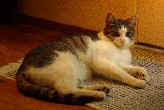FIELD GUIDE TO HEALTHY CAT LITTER
- The importance of choosing healthy cat litter. - The choice of litter can support the health of a cat and its owner or be a source of stress and a cause of illness. According to a study published in the Journal of Applied Animal Welfare Science in 2000, the primary reason that cats are surrendered to shelters is because they stop using the litter box. Could something as simple as a change of cat litter prevent this? Most people are familiar with clumping clay litter. Indoor cats struggled with ashes, sawdust or newspapers until the invention of baked ground clay kitty litter in 1947. Six decades later, U.S. litter boxes are increasingly being filled with renewable litters made from plant sources like wheat, cedar, and corn.
- Clay litter is inexpensive, with great odor control. Clay is also; dusty, sticky, non-renewable and harder to pass if ingested. Regrettably, cats routinely ingest some litter while grooming. Long-haired cats (more litter gets stuck in their fur) and kittens may experience digestive difficulties with clay litters. Clay litters could be more practical for households with only adult cats, or cats who refuse to switch litters.
- Plant-based litters are now widely available and affordable. Whether made of wheat grass, corn, soybeans or cedar, the effectiveness of a plant-based litter’s odor control is due to its natural enzymes as well as its particle size or clumping-characteristics. Plant-based litters are often well suited to households with animals who ingest larger quantities of litter. Such animals include kittens, dogs who live with cats, and long-haired cats.
- Wood Pellet animal bedding often sold in feed stores for horse bedding can be a good low cost cat litter. Most cats use it willingly and, because wood is a natural ammonia neutralizer, cat litter odor becomes almost non-existent. Select wood pellet bedding with ammonia absorbing zeolites for added odor control. Zeolites are naturally occurring minerals used in many food products and clumping litters.
To use place 1" to 1-1/2" of pellet bedding in each litter pan. Pellets become sawdust when wet. To remove waste: 1. Shake the litter pan to move feces to the top and sawdust to the bottom, 2. Remove feces, 3. Brush pellets to one side of pan, 4. Scoop remaining pellets/sawdust and shake the scoop over a waste container to remove the sawdust, returning pellets to the litter pan, 5. Repeat step 4 until the sawdust has been removed, 6. Add more pellets if needed, 7. Replace all pellets and clean the litter pan as needed, about every 2 weeks.
Animal pellet bedding sold in 40 lb bags at a feed store can be 60% to 80% cheaper than the same amount of litter purchased from a food or pet store.
The Right Shapes for Little Cat Feet (and Noses) The particle size of a litter impacts clumping, odor control, how comfortable the litter will be for a cat to walk on, tracking and stickiness. There are many textures of litter, but some of the most common are:
- Large Pellets, which do not clump. This requires more frequent litter box changes but the pellets are also much less likely to track. Large pellets are well suited for:
Large cats – larger pellets support their weight better
Indoor/outdoor cats – the pads of their feet are tougher than their indoor-only counterparts
Long-haired cats – large pellets are much less likely to get stuck in their fur
Cats who live with other cats – because they cost less than many other types of litter, large pellets may be a good choice for multi-cat households.
- Small Pellets, which may clump. Because of their increased surface area, small pellets are much more likely to stick together than large pellets when they get wet. These types of litters do not clump as firmly as granular clumping litters, but they also track less. Small pellet litters may contain additives to aid in clumping, and may be popular with:
Cats in multi-cat households – small pellets provide a good balance of odor control and low cost
Cats who leave footprints – small pellets are less dusty and less likely to track than granules.
- Granules, which are designed specifically to clump. This allows for easy maintenance and improved odor control; however, the smaller particle size means more litter will be tracked outside the box. Granular litters may work best for:
Short-haired cats – they have less fur for the granules to stick to
Indoor-only and de-clawed cats – granules are easy on tender feet
Cats in smaller residences – the odor control of a clumping litter will make the box easier to live with for both cats and humans alike.
